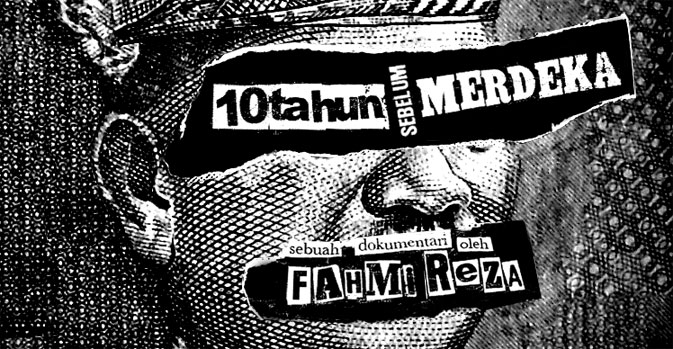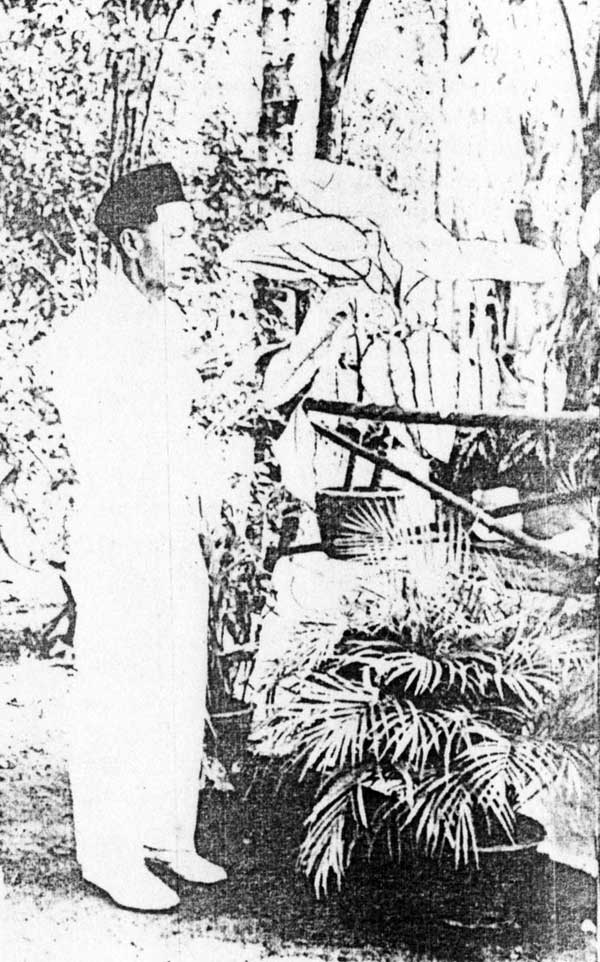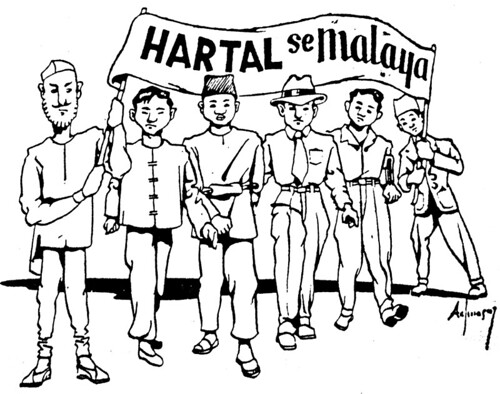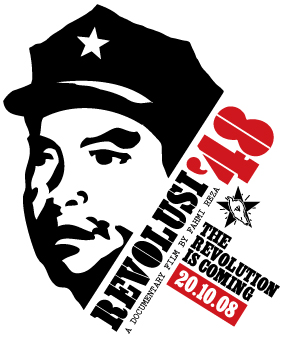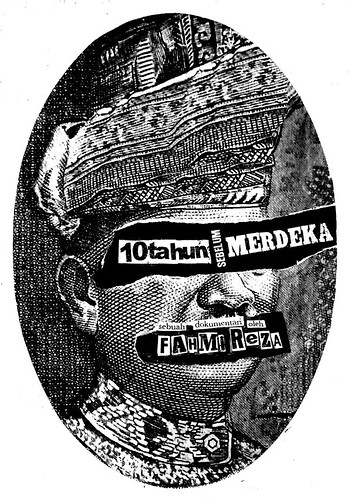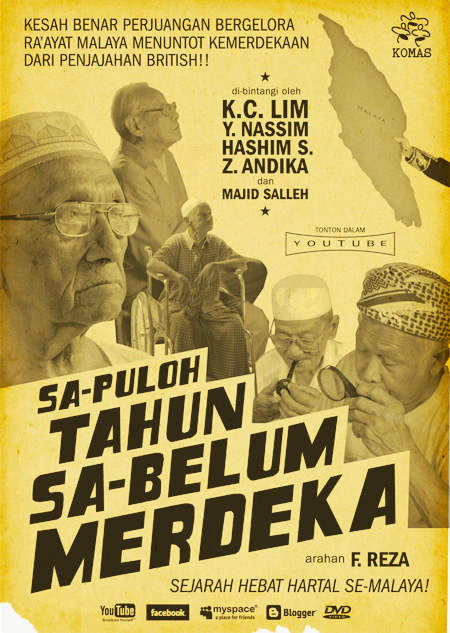
Poster versi 1947! Homage kepada poster² filem zaman kegemilangan studio Malay Film Productions dan Cathay-Keris Films.
Khamis, Januari 31, 2008
Sa-puloh Tahun Sa-belum Merdeka (1947)
Dicatat oleh
Fahmi Reza
di
7:42 PG
6
ulasan
![]()
Kategori: DIY Marketing
Isnin, Januari 28, 2008
Lagu "Darah Rakyat"
DARAH RAKYAT
Darah rakyat masih berjalan
Menderita sakit dan miskin
Padanya datang pembalasan
Rakyat yang menjadi hakim
Rakyat yang menjadi hakim
Ayuh! ayuh!
Bergerak! Sekarang!
Merah Putih panji-panji kita
Merah warna darah rakyat
Merah warna darah rakyat
Darah Rakyat merupakan lagu perjuangan rakyat yang lahir semasa Revolusi Indonesia 1945. Seperti lagu "Indonesia Raya" yang merupakan lagu Kebangsaan PKMM, perjuangan kemerdekaan rakyat Indonesia banyak mempengaruhi pemikiran rakyat di Malaya. Lagu ini selalu dinyanyikan semasa perbarisan dan perhimpunan PKMM dan API untuk menaikkan semangat pemuda-pemudi pada zaman kebangkitan gerakan kemerdekaan rakyat di Malaya selepas perang dunia kedua (1945-1948).
Jumaat, Januari 25, 2008
Kongres Ketiga PKMM (1947)

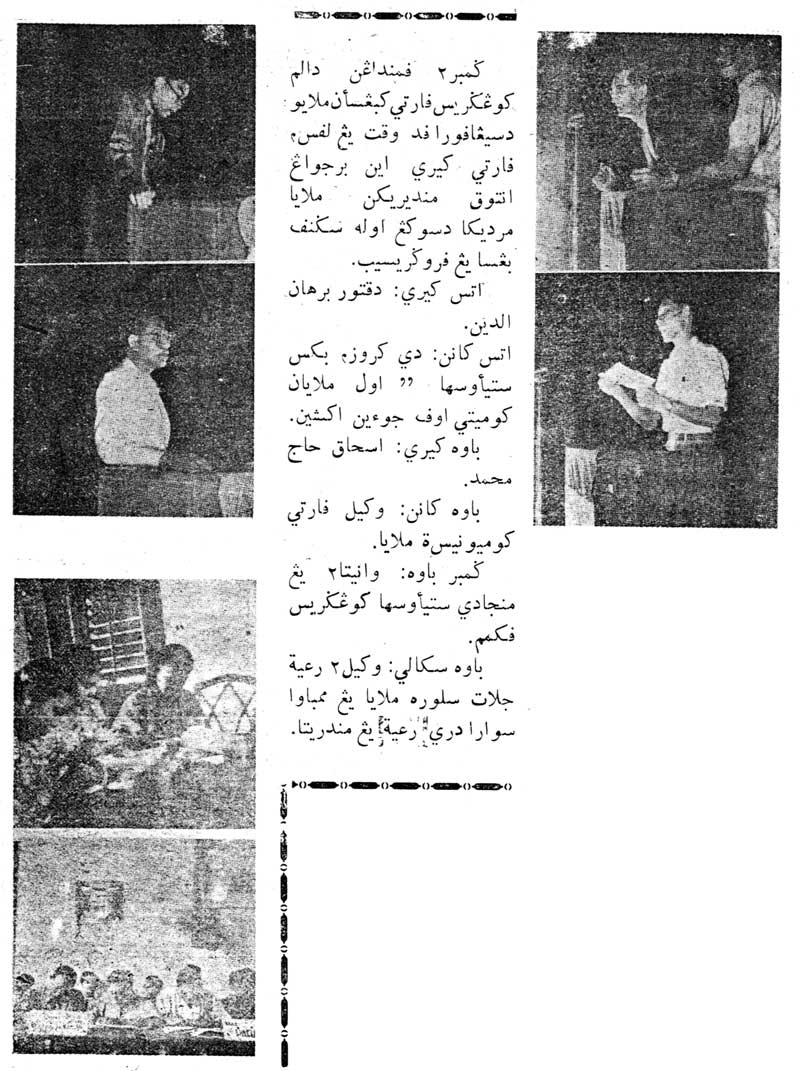
Gambar² pemandangan dalam kongres Parti Kebangsaan Melayu di Singapura pada waktu yang lepas, parti kiri ini berjuang untuk mendirikan Malaya Merdeka disokong oleh segenap bangsa yang progresif.
Atas kiri: Dr. Burhanuddin
Atas kanan: De Cruz, bekas setiausaha All-Malayan Committee of Joint Action
Bawah kiri: Ishak Hj. Muhammad
Bawah kanan: Wakil Parti Komunis Malaya
Gambar bawah: Wanita² yang menjadi setiausaha kongres PKMM
Bawah sekali: Wakil² rakyat jelata seluruh Malaya yang membawa suara dari rakyat yang menderita
Sumber: Buku ‘Album Malaya Merdeka 31 Ogos 1957’, Qalam, 1957
Dicatat oleh
Fahmi Reza
di
10:25 PTG
0
ulasan
![]()
Kategori: Badan Politik, Foto
Kongres Kedua PKMM (1946)

Diantara pemimpin² dari Parti Kebangsaan Melayu Malaya dan Angkatan Pemuda Insaf bergambar selepas mengadakan kongres yang kedua pada 25-27 Disember 1946 di Kota Melaka.
Anggota² Dewan Pimpinan PKMM yang dilantik semasa kongres:
Yang Dipertua: Dr. Burhanuddin Al-Helmy
Naib Yang Dipertua: Ishak Hj. Muhammad
Setiausaha Agung: Abdul Hamid Abdul
Penolong Setiausaha Agung: Mohamad Mustaza
Bendahari: Yahya Nassim
Penolong Bendahari: Aziz Hamidy
Ketua Pemuda: Kamaluddin Mohammad (Keris Mas)
Ketua Wanita: Shamsiah Fakeh
Sumber: Buku ‘Album Malaya Merdeka 31 Ogos 1957’, Qalam, 1957
Dicatat oleh
Fahmi Reza
di
10:10 PTG
0
ulasan
![]()
Kategori: Badan Politik, Foto
Selasa, Januari 22, 2008
Testament Politik A.P.I. (1946)
 Angkatan Pemuda Insaf (API) adalah sebuah badan politik kiri pemuda² radikal yang ditubuhkan pada 17 Februari 1946 di Ipoh, Perak yang pada asalnya merupakan sayap pemuda PKMM. API ditubuhkan untuk menyatu-padukan pemuda² Melayu dalam satu gerakan pemuda yang kemudiannya akan bergabung dengan pemuda² Malaya yang lain dalam Malayan New Democratic Youth League (MNDYL) untuk mencapai cita² Malaya Merdeka. Buku Testament Politik A.P.I. ini telah ditulis sempena Kongres Pertama API di bandar Melaka pada 22, 23 & 24 Disember 1946. Di bawah ialah kata² pendahuluan untuk buku kecil Testament Politik A.P.I. yang ditulis oleh Ahmad Boestamam, Ketua Angkatan Pemuda Insaf.
Angkatan Pemuda Insaf (API) adalah sebuah badan politik kiri pemuda² radikal yang ditubuhkan pada 17 Februari 1946 di Ipoh, Perak yang pada asalnya merupakan sayap pemuda PKMM. API ditubuhkan untuk menyatu-padukan pemuda² Melayu dalam satu gerakan pemuda yang kemudiannya akan bergabung dengan pemuda² Malaya yang lain dalam Malayan New Democratic Youth League (MNDYL) untuk mencapai cita² Malaya Merdeka. Buku Testament Politik A.P.I. ini telah ditulis sempena Kongres Pertama API di bandar Melaka pada 22, 23 & 24 Disember 1946. Di bawah ialah kata² pendahuluan untuk buku kecil Testament Politik A.P.I. yang ditulis oleh Ahmad Boestamam, Ketua Angkatan Pemuda Insaf.
Buku testament politik A.P.I. ini saya susun dengan bergopoh². Isi-nya ia-lah dengan sechara ringkas sahaja. Masa dan keadaan tidak membenarkan supaya buku ini di-tulis panjang².
Di-dalam-nya ada di-terangkan dengan sechara ringkas tetapi padat tentang tenaga pemuda, pergerakan pemuda di-dunia, pergerakan pemuda di-Malaya dan juga tentang pergerakan A.P.I. (Angkatan Pemuda Insaf) dan tujuan² politik-nya.
Moga² buku ini akan mendatangkan faedah kapada pemuda2 Melayu 'am-nya dan pemuda² A.P.I. khas-nya.
Pemuda² Melayu - Insaf-lah.
MERDEKA dengan DARAH
A. BOESTAMAM.
Kuala Lumpur,
21-12-46
Download dokumen PDF untuk baca buku kecil ini:
Testament Politik A.P.I. (1946)
Dicatat oleh
Fahmi Reza
di
11:20 PG
3
ulasan
![]()
Kategori: Badan Politik
Sabtu, Januari 19, 2008
10tahun @ Youth'08 PWTC
 Bagi menyebarkan mesej 10tahun kepada muda-mudi kotaraya, kita ada bukak meja dalam acara Youth'08 di PWTC (Hall 3) sampai Ahad esok dari 10 pagi sampai 10 malam. Ada t-shirt & DVD 10tahun untuk dijual. Kalau korang takde duit nak beli DVD, datang lah PWTC hari ni atau esok dan bawak thumbdrive untuk download filem 10tahun secara percuma!
Bagi menyebarkan mesej 10tahun kepada muda-mudi kotaraya, kita ada bukak meja dalam acara Youth'08 di PWTC (Hall 3) sampai Ahad esok dari 10 pagi sampai 10 malam. Ada t-shirt & DVD 10tahun untuk dijual. Kalau korang takde duit nak beli DVD, datang lah PWTC hari ni atau esok dan bawak thumbdrive untuk download filem 10tahun secara percuma!
Dicatat oleh
Fahmi Reza
di
7:26 PG
2
ulasan
![]()
Kategori: DIY Marketing
Khamis, Januari 17, 2008
10tahun @ Empower's 2nd KopiOnite

Empower's 2nd KopiOnite presents 10 Tahun Sebelum Merdeka
Free film screening & discussion with the filmmaker Fahmi Reza
Click here for map and directions
Dicatat oleh
Fahmi Reza
di
4:10 PG
0
ulasan
![]()
Kategori: Masa Tayangan
Ahad, Januari 13, 2008
Kartun Politik: Democracy Ditahan Jajahan? (1947)

Pada petang Khamis, 13 Mac 1947, Ahmad Boestamam, Ketua Angkatan Pemuda Insaf (API) telah ditahan oleh polis dan Special Branch Kerajaan Kolonial British dan dihadapkan ke mahkamah atas 3 tuduhan:
PERTAMA: Pada 21 Disember 1946, mengeluarkan sebuah buku kecil bernama "Testament Politik API" di Kuala Lumpur yang mengandungi perkataan² menghasut dan juga mengeluarkan perkataan "Merdeka dengan Darah", iaitu perbuatan menghasut mengikut undang² Sub-Section B, Tahun 1939.
KEDUA: Menerbitkan buku kecil tersebut adalah salah di sisi undang² Section 4, 1c undang2 13, Tahun 1939, dan 109 Penal Code.
KETIGA: Mencetak buku kecil tersebut, dituduh salah mengikut undang² seperti tuduhan kedua.
Ahmad Boestamam yang dibela oleh peguam John Eber (Malayan Democratic Union) telah didapati bersalah atas ketiga² tuduhan dan dikenakan hukuman denda $1,000 atau 6 bulan penjara kerjaberat untuk tuduhan pertama, $200 atau 1 bulan penjara untuk tuduhan kedua, dan $200 atau 1 bulan penjara untuk tuduhan ketiga. Dengan bantuan wang dari rakan2 perjuangannya, beliau memilih untuk membayar denda untuk mengelak dari dipenjara.
Ini satu contoh bagaimana Kerajaan Kolonial British mula mencengkam gerakan kiri dan menyekat ruang demokrasi rakyat. Seperti kata² Lim Kean Chye dalam filem 10 Tahun Sebelum Merdeka, "the British were beginning to show their hands... that they're gonna come back very strong and restore Colonial rule..."
Dicatat oleh
Fahmi Reza
di
11:53 PG
0
ulasan
![]()
Kategori: Kartun Politik
Sabtu, Januari 12, 2008
Temubual dalam majalah Off The Edge, Jan 2008

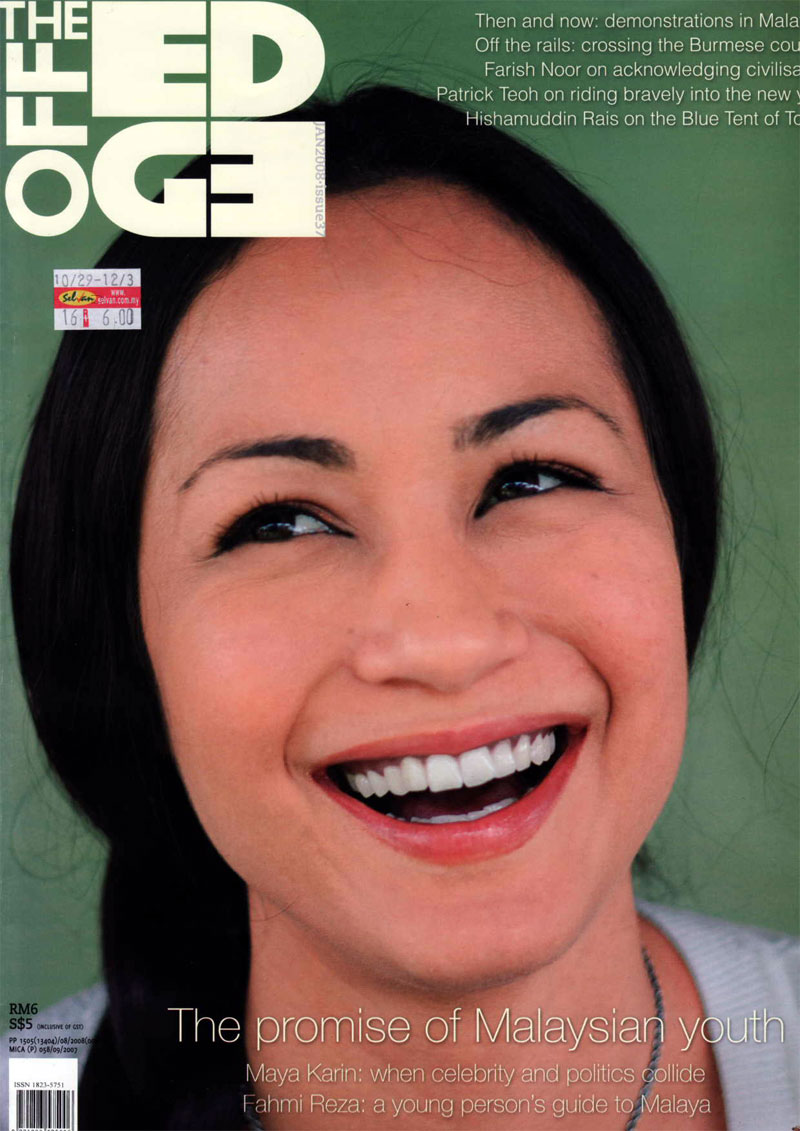 Temubual antara Beth Yahp dengan Fahmi Reza, pengarah filem 10 Tahun Sebelum Merdeka dalam majalah Off The Edge, Januari 2008.
Temubual antara Beth Yahp dengan Fahmi Reza, pengarah filem 10 Tahun Sebelum Merdeka dalam majalah Off The Edge, Januari 2008.
Di bawah merupakan intro asal yang ditulis oleh Beth Yahp untuk artikel tersebut, tetapi tidak sempat dihantar sebelum cetakan.
FAHMI REZA’s documentary 10 Tahun Sebelum Merdeka premiered at KOMAS’ Freedom Film Festival in September this year, and in the short time since then has already collected a garland of accolades from viewers and reviewers, as well as winning the Festival’s ‘Most Outstanding Human Rights Film’ prize.
Made on a shoestring budget and the goodwill plus donated labour of a posse of friends, it was propelled by one man’s curiosity about the hidden alternative history of the Malayan rakyat’s struggle for independence in 1947, which led to no mean feats: a country-wide hartal (general strike) supported by the Chinese Chamber of Commerce, no less, and a proposed (but ignored) People’s Constitution.
By 1948, as Fahmi’s film reminds us, many of the leaders and members of the multi-ethnic coalition that spearheaded these remarkable events, had been arrested under British Emergency laws (such as an earlier version of the ISA) and their story swept under the carpet of a revised version of Malaya’s history.
Beth Yahp caught up with Fahmi at the cafeteria of the Universiti of Malaya in October after a screening at the Law Faculty attended by a scattering of law students, and following that over email and chats. She also attended several full-house screenings of his film, which were followed by lively and often astounded discussions. Asked how they felt after one screening, the students replied: ‘Terkejut.’ ‘Tak puas hati.’ ‘Tertipu lah…’
Beth and Fahmi’s conversation was conducted in English and Malay, some of which was later translated into English. As Fahmi remarked, ‘Borak-borak pun boleh jadi interview di magazine…’ But that’s how stories and ideas get passed on. As Fahmi also says, ‘You can’t copyright ideas.’
See Fahmi’s blogspot: http://10tahun.blogspot.com/ for more stories, ideas, songs, comments, newspaper articles and photos about this little-known part of our history.
Download dokumen PDF untuk baca seluruh temubual tersebut:
A Young Person's Guide To Malaya
Dicatat oleh
Fahmi Reza
di
2:43 PG
2
ulasan
![]()
Kategori: Liputan Media
Jumaat, Januari 11, 2008
Uniform Orang Pekemam ﻓﻜﻤﻢ
Struktur organisasi PUTERA-AMCJA
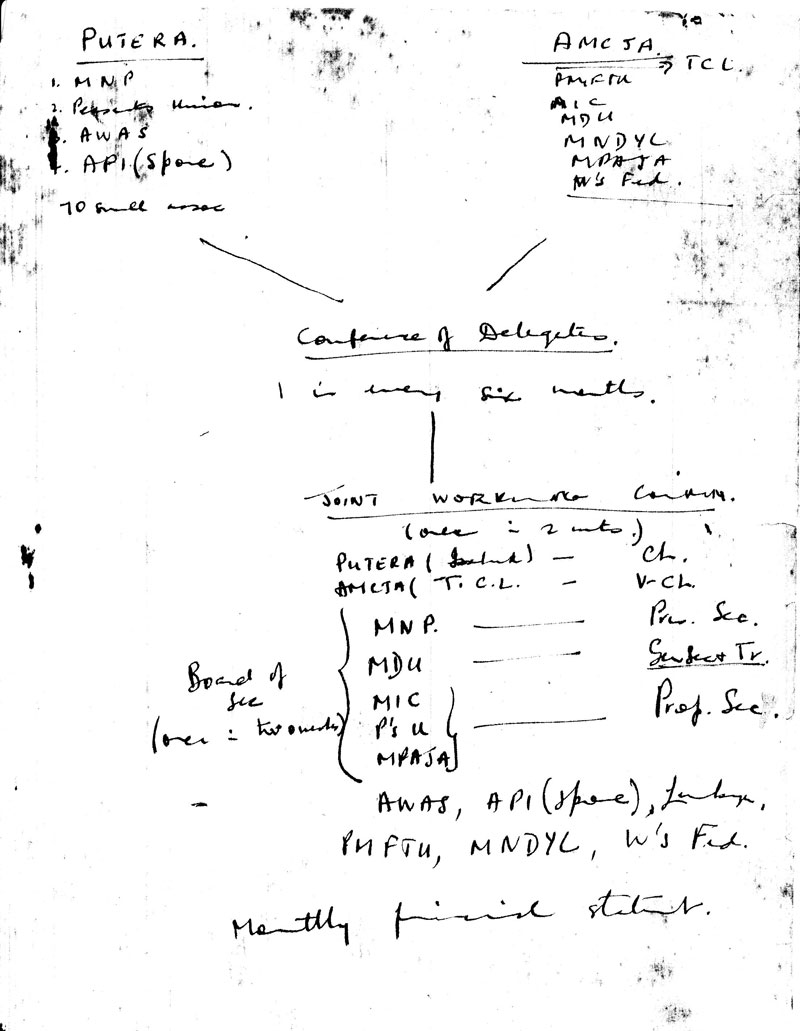
Nota yang penuh dengan akronim ni aku temui di Arkib Negara dalam koleksi Tan Cheng Lock Papers. Nota ni tak bertarikh, kebarangkalian besar ditulis selepas Hartal, semasa persidangan Conference of Delegates PUTERA-AMCJA yang pertama di Kuala Lumpur pada 3 November 1947. Berdasarkan tulisan tangannya, yang pasti, ia ditulis oleh Tan Cheng Lock sendiri. Nota ini mendedahkan secara ringkas struktur organisasi PUTERA-AMCJA. Di sini biar aku cuba terangkan isi kandungan nota kecil ni.
Dua badan politik utama yang membentuk PUTERA-AMCJA ialah Pusat Tenaga Ra'ayat (PUTERA) dan All-Malaya Council of Joint Action (AMCJA).
PUTERA dianggotai oleh:
1. Malay Nationalist Party (MNP) atau Parti Kebangsaan Melayu Malaya (PKMM)
2. Peasants Union atau Barisan Tani Se-Malaya (BATAS)
3. Angkatan Wanita Sedar (AWAS)
4. Angkatan Pemuda Insaf (API)
dan 70 pertubuhan2 kecil.
AMCJA pula dianggotai oleh:
1. Pan-Malayan Federation of Trade Unions (PMFTU)
2. Malayan Indian Congress (MIC)
3. Malayan Democratic Union (MDU)
4. Malayan New Democratic Youth League (MNDYL)
5. Malayan People's Anti-Japanese Army Ex-Service Comrades Association (MPAJA)
6. Women's Federation (W's Fed)
bersama Tan Cheng Lock (TCL) sebagai Pengerusi.
Kedua² badan ini akan bersidang dalam satu Persidangan Wakil² Delegasi (Conference of Delegates), enam bulan sekali. Setiap tahun Conference of Delegates ini akan melantik satu Jawatankuasa Kerja Bersama (Joint Working Committee) yang bertanggungjawab untuk melaksanakan polisi yang ditetapkan semasa persidangan. Jawatankuasa ini akan bermesyuarat dua bulan sekali.
Joint Working Committee ini dianggotai oleh:
1. PUTERA sebagai Pengerusi (Chairperson) - diwakili oleh Ishak Hj. Muhammad
2. AMCJA sebagai Timbalan Pengerusi (Vice-Chairperson) - diwakili oleh Tan Cheng Lock
3. Ahli Lembaga Setiausaha (Board of Secretaries):
a. MNP sebagai Setiausaha Persidangan (Presiding Secretary)
b. MDU sebagai Setiausaha Umum (General Secretary) dan Bendahari (Treasurer)
c. MIC, BATAS dan MPAJA sebagai Setiausaha Propaganda (Propaganda Secretary)
4. Ahli² Jawatankuasa: AWAS, API, Lembaga Kesatuan Melayu Johor, PMFTU, MNDYL dan Women's Federation
Bahan² sejarah menarik macam ni lah yang buat aku minat menyelidik tentang sejarah.
Sumber: Koleksi Tan Cheng Lock Papers, Arkib Negara Malaysia
Dicatat oleh
Fahmi Reza
di
2:46 PTG
2
ulasan
![]()
Kategori: PUTERA-AMCJA
Khamis, Januari 10, 2008
Perlembagaan Rakyat vs. Perlembagaan Federation
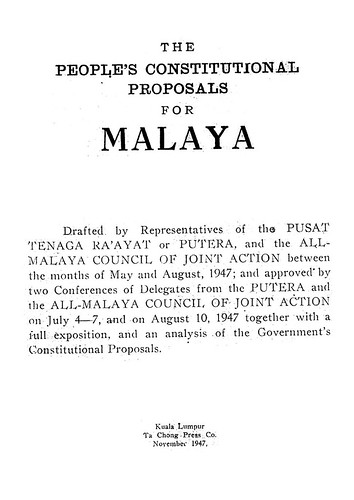
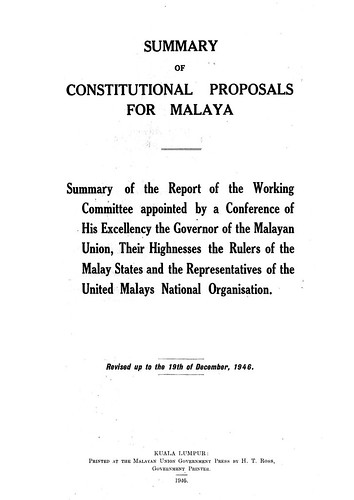
Malaya, 1947, sepuluh tahun sebelum merdeka.
Di sebelah kiri ada Perlembagaan Rakyat yang disusun oleh Pusat Tenaga Ra'ayat dan All-Malaya Council of Joint Action (PUTERA-AMCJA).
Di sebelah kanan pula ada Perlembagaan Federation yang disusun oleh Kerajaan Kolonial British, Raja2 Melayu dan United Malays National Organisation (UMNO).
Sekarang kamu boleh baca dan bandingkan sendiri kedua2 cadangan Perlembagaan baru untuk Malaya pada tahun 1947 ni.
Kalau kamu hidup pada zaman tu, Perlembagaan mana yang menjadi pilihan kamu?
Download dokumen PDF Perlembagaan Rakyat (3.6MB):
Peoples Constitution (1947)
Download dokumen PDF Perlembagaan Federation (0.6MB):
Federation Proposals (1946)
Dicatat oleh
Fahmi Reza
di
5:08 PTG
16
ulasan
![]()
Kategori: Perlembagaan Rakyat, PUTERA-AMCJA
Selasa, Januari 08, 2008
Lagu "Burhanuddin Al-Helmy"
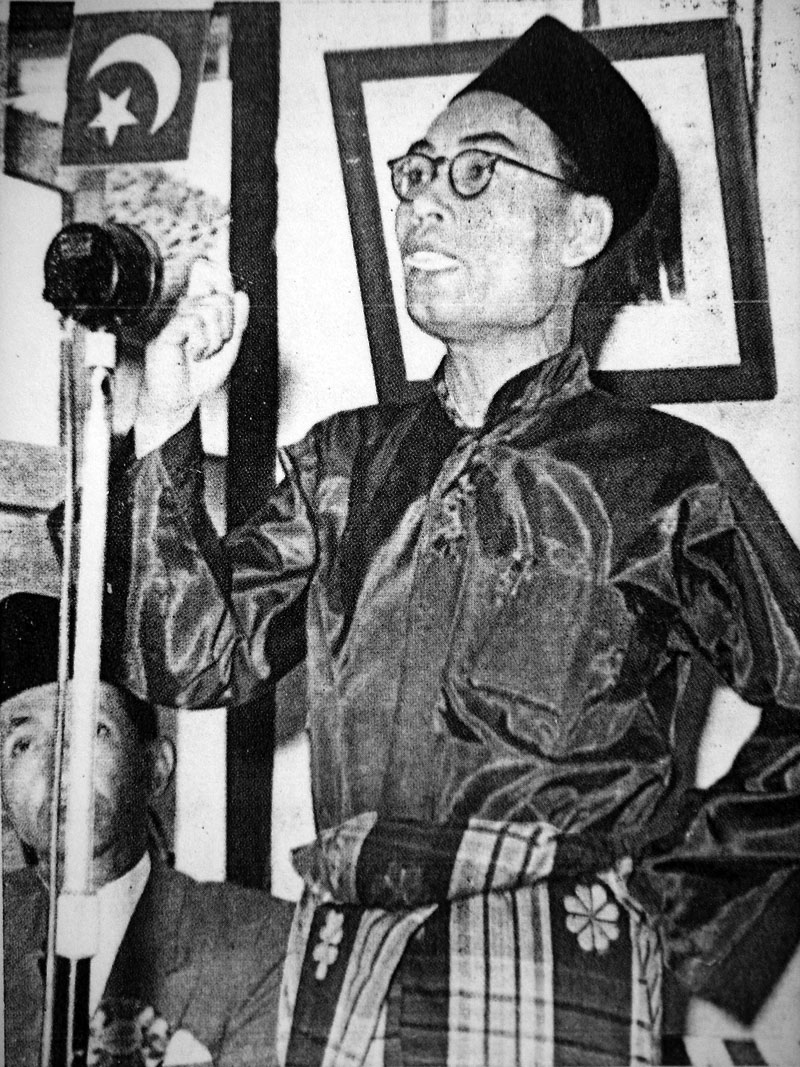
BURHANUDDIN AL-HELMY
oleh Black
Ku ciptakan lagu untukmu
Ku nyanyikan syair buatmu
Tentang perjuangan
Tentang pengorbanan
Kau yang bertubuh kecil
Tetapi berjiwa besar
Tegas pendirian
Dan berhati mulia
Dari utara hingga selatan
Lantang suaramu
Menentang penjajahan
Melawan penindasan
Demi untuk negara
Demi untuk merdeka
Kau sering terpenjara
Kebebasanmu dirampas
Tapi, jiwamu tetap merdeka
Di atas robohan kota Melaka
Kita dirikan jiwa merdeka
Kata-kata azimat darimu
Tak pernah kami lupa
Walaupun kini jasadmu telah tiada
Namun semangatmu membakar jiwa
Rakyat Malaysia yang tak pernah melupakan
Pengorbananmu
Rakyat Malaysia yang cintakan
Perjuanganmu
Klik link ini untuk baca artikel dari tahun 1946 mengenai Dr. Burhanuddin Al-Helmy: Men That Matter - Leaders of Young Malaya
Isnin, Januari 07, 2008
Lagu "Darah Juang"
DARAH JUANG
oleh Somasi Group
Di sini negeri kami
Tempat padi terhampar
Samuderanya kaya raya
Tanah kami subur, Tuhan
Di negeri permai ini
Berjuta rakyat bersimbah luka
Anak kurus tak sekolah
Pemuda desa tak kerja
Mereka dirampas haknya
Tergusur dan lapar
Bonda, relakan darah juang kami
Untuk membebaskan rakyat
Mereka dirampas haknya
Tergusur dan lapar
Bonda, relakan darah juang kami
Padamu kami berjanji
Darah Juang adalah sebuah lagu perjuangan mahasiswa Indonesia yang lahir semasa zaman Reformasi yang menumbangkan Rejim Orde Baru Suharto pada tahun 1998. Ia ditulis oleh 2 orang pemimpin aktivis mahasiswa dari Universiti Gadjah Mada (UGM) Yogyakarta, John Sonny Tobing dan Andi Munafat. Lagu ini popular sebagai lagu yang wajib dinyanyikan dalam setiap demonstrasi mahasiswa di seluruh Indonesia.
Artikel dari The Edge Daily, 4 Jan 2008
 WHAT MIGHT HAVE BEEN AND STILL COULD BE
WHAT MIGHT HAVE BEEN AND STILL COULD BE
by Lee Wei Lian
Given that this is the golden anniversary of Malaysia's independence — though technically, Malaysia didn't exist till 1963 — I am choosing the topic of national unity for my year-end commentary. You must be wondering of course, what the topic of national unity is doing in a section on technology and innovation? Well, it's an important issue, one that is central to any country's success and, unfortunately for us, it's an issue that has become like some sort of eternal black hole, sucking in much attention, time and energy, but with no good results. But I will also make an effort to segue from national unity to the innovative use of technology.
Having travelled through a number of multi-ethnic, multi-lingual societies, I must acknowledge the difficulties that come with knitting diverse tribes into a cohesive whole. In 1997, I was in Canada watching tears roll down the cheeks of a lady making a plea on national TV to French-speaking Quebecois to vote against separation in a secession referendum. I have been to Barcelona, Spain, where people prefer to refer to themselves as Catalan rather than Spanish. I visited Bilbao, also in Spain, and heart of Basque country where there is also more pride in being Basque than Spanish and separatist organisations like ETA use bombs to prove that point. Belgium has been the object of pundit affection lately because of the odds of it crumbling into its Flemish and Wallonian constituent parts.
There are of course, my favourite examples.
I once took a train journey from Geneva to Bern in Switzerland. The train was spotless and right on schedule as expected. But what amazed me was that the conductor checking tickets spoke French in the Geneva canton (the Swiss version of a state) and when the train was travelling through the Bern canton less than an hour later, the very same conductor switched smoothly to German. Yet, the country is fiercely united and very successful. I read recently that tennis great Roger Federer, who hails from the German speaking town of Munchenstein, trained at the Swiss National Tennis Center in French speaking Eculbelns, even though his French was not very good at the time. Yet today, he is without peer in the tennis world and claimed proudly by all Swiss. Basel, a city that speaks both French and German, is the centre of gravity for the pharmaceutical industry. Whether in the field of finance, fancy watches or Nobel prizes, peculiarly diverse Switzerland is a global leader.
Then there is the US — the most ethnically diverse nation on earth and the only superpower to boot. I spent nearly half a decade in the US observing how Iranians, Jews, Whites, Blacks, Asians and Latinos live together in many ways similar to how Malays, Chinese, Indians, Kadazans and Ibans live together in Malaysia. One major difference though, is how, over there, national identity is emphasised so much more compared to here. Anything and everything there is about being an American, unlike here. And that, I believe is the reason unity is fragile in Malaysia while in the US, it is not. How can you unite when there is no identity to unite under?
But it didn't have to be this way. Way back in 1946, there was a courageous attempt by civil society right here in Malaysia, to architect a nation, where I believe, the national unity would have been a lot stronger than today. Thanks to YouTube, I was able to watch 10 Tahun Sebelum Merdeka (10 Years Before Independence) by Fahmi Reza at my convenience. According to the documentary, compiled from eyewitness accounts and newspaper reports, there was an alternative constitution proposed for Malaya in 1946, called the People's Constitution. This constitution proposed that Malaya gain its independence and all who call it their real home would be known as Malays. That's right — Malays. Also proposed in the document was that all would get equal political rights but with special protection for Malays, there would be a council to combat racial discrimination and Singapore would be part of Malaya. Four hundred thousand copies of the People's Constitution in three languages were distributed. Judging from comments left on the Internet, after many viewers got over the shock of being kept ignorant of the People's Constitution, their next reaction is that they cannot believe how enlightened the drafters of the document were back then.
When the British ignored this democratic cry for independence, on Oct 20, 1947, about 10 years before Merdeka, Malayans went on a nationwide strike. Railways, towns and rubber estates were silent for 22 days [Sebenarnya mogok hartal berlaku selama 18 jam dari 6 pagi hingga 12 tengah malam pada 20 Okt 1947. -Ed] — that was how widespread the support was for the People's Constitution. If the voice of the people had been heeded back then, well, we'd all be Malays today and putting an extra 10 candles on our birthday cake. But the powers in control back then decided to rubbish it in favour of an alternative constitution drawn up together with Umno, which created the Federation of Malaya in 1947. This effectively divided society, therefore delineating and strengthening racial fault lines that persist to this day and weakened the foundations for a strong national identity. That's not all. They also threw many of the people involved in promoting and drafting the People's Constitution, including some 10,000 Malays, into jail.
In an interview with theSun, Fahmi said that the drafters of the People's Constitution "wanted to give birth to a new bangsa. They were conscious about breaking the Malay-Chinese-Indian racial categorisations. They wanted to forge a new nationality regardless of race".
I personally believe a national identity forged by the people for the people in esprit de corps would have led to stronger unity than one imposed from above.
The documentary is a moving one. To make it, Fahmi interviewed members of organisations that made the People's Constitution possible. There was Lim Kean Chye (Malayan Democratic Union) and Yahya Nassim Hussein (Parti Kesatuan Melayu Malaya) [Parti Kebangsaan Melayu Malaya -Ed], among others. The music, sometimes haunting, at other times stirring, can make your hair, literally, stand on end. And their stories, animated by battle-scarred faces nearly 90 years old, can bring tears to your eyes. Some moments can be amusing, as when Yahya touches on the issue of flags: "Kenapa nak taruk keris kat situ? (Why do you want to put a keris on it?)" Other moments are sad like when he relates how certain parties tried to turn Malays against the Chinese and Indians using a technique known as "Ah Chong-Ramasamy." I guess some things don't change, even today.
Despite being made for a bare-bones budget of just RM5,000, I find 10 Tahun a better film than many US$100-million (RM336 million) productions from Hollywood. Technology, of course, is why this is possible. It is unlikely Fahmi could have achieved the same quality and audience at this cost 10 years ago. With digital cameras, PC-based editing applications and YouTube, anyone with the passion and talent can make and distribute quality docufilms.
Which brings me to how technology can help build national unity. The Internet is a marvelous platform where diverse groups can meet and mingle despite being in physically remote locations. Discussion in blogs and other forums are largely unfettered and self-regulated and, as we can see, no riots have broken out because of it. On the contrary, discussions show that the pygmification of the Malaysian intellect is not yet complete and, through interaction, understanding is deepened. It can also be a repository for alternative views. Fahmi's 10 Tahun is an alternative retelling of our nation's history and is now part of the global knowledge bank and accessible to all no matter what the Ministry of Education chooses to do with Sejarah textbooks. I'm just waiting for someone to do a documentary on Hang Tuah and certain momentous events in the nation's history. It can also be a way for anthropologists and sociologists to gain insight into the thinking and aspirations of the nation. And perhaps a place for people to organise civil-society initiatives for unity as there is a sense of great freedom on the Internet, perhaps in some sense similar to the feeling of the post war years, of which Lim says: "There was a general feeling of liberation in the air." So happy birthday Malaysia and may your next 50 be more united than the last.
Sumber: theedgedaily.com, 4 Jan 2008
Dicatat oleh
Fahmi Reza
di
7:37 PG
0
ulasan
![]()
Kategori: Liputan Media
Selasa, Januari 01, 2008
Lagu "Nyanyi Budaya Pembebasan"
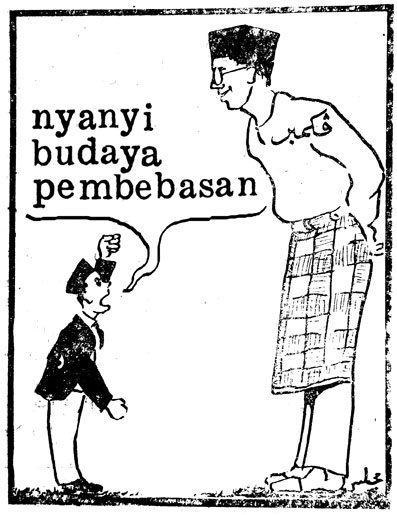
NYANYI BUDAYA PEMBEBASAN
oleh Sanggar Satu Bumi
Kepalkan tinjumu ke awan
Nyanyi budaya pembebasan
Rapatkan barisanmu kawan
Hancurkan segala penindasan
Yo semua turun ke jalan
Lantang suarakan segala tuntutan
Hancurkan feudalisme, militarisme dan kapitalisme
Jangan ragu, ayoh bersatu
Yakinlah rakyat pasti menang
Yakinlah rakyat pasti menang!
